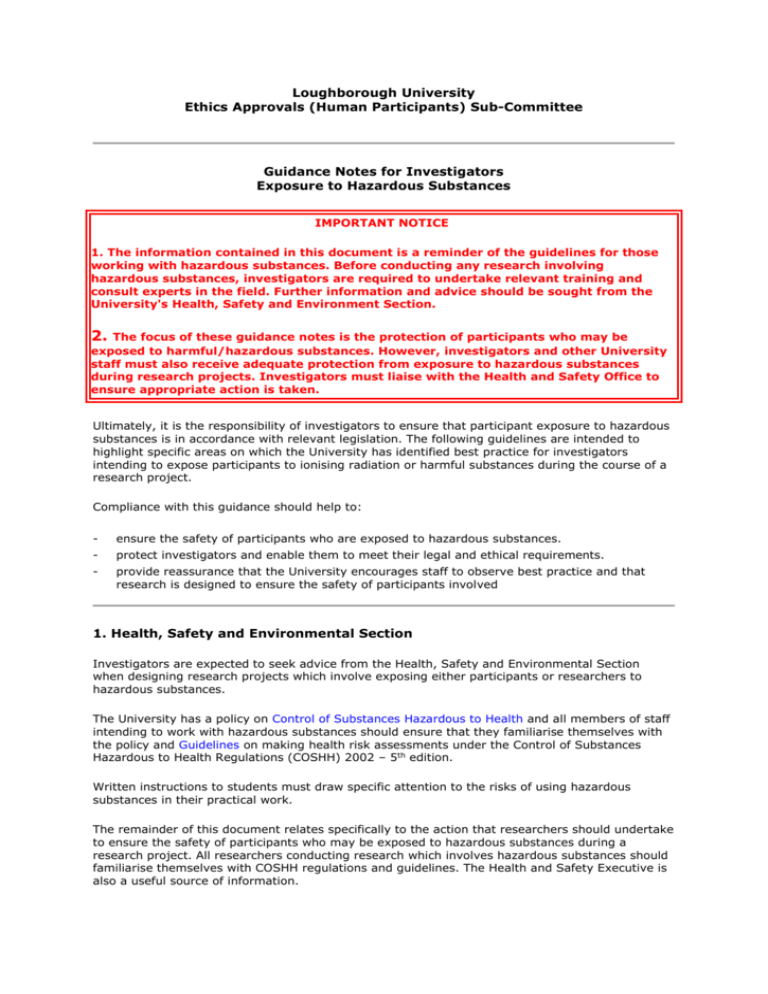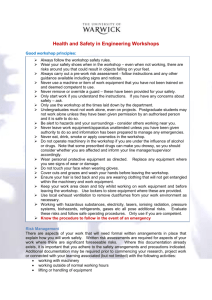
Loughborough University
Ethics Approvals (Human Participants) Sub-Committee
Guidance Notes for Investigators
Exposure to Hazardous Substances
IMPORTANT NOTICE
1. The information contained in this document is a reminder of the guidelines for those
working with hazardous substances. Before conducting any research involving
hazardous substances, investigators are required to undertake relevant training and
consult experts in the field. Further information and advice should be sought from the
University's Health, Safety and Environment Section.
2.
The focus of these guidance notes is the protection of participants who may be
exposed to harmful/hazardous substances. However, investigators and other University
staff must also receive adequate protection from exposure to hazardous substances
during research projects. Investigators must liaise with the Health and Safety Office to
ensure appropriate action is taken.
Ultimately, it is the responsibility of investigators to ensure that participant exposure to hazardous
substances is in accordance with relevant legislation. The following guidelines are intended to
highlight specific areas on which the University has identified best practice for investigators
intending to expose participants to ionising radiation or harmful substances during the course of a
research project.
Compliance with this guidance should help to:
-
ensure the safety of participants who are exposed to hazardous substances.
-
protect investigators and enable them to meet their legal and ethical requirements.
-
provide reassurance that the University encourages staff to observe best practice and that
research is designed to ensure the safety of participants involved
1. Health, Safety and Environmental Section
Investigators are expected to seek advice from the Health, Safety and Environmental Section
when designing research projects which involve exposing either participants or researchers to
hazardous substances.
The University has a policy on Control of Substances Hazardous to Health and all members of staff
intending to work with hazardous substances should ensure that they familiarise themselves with
the policy and Guidelines on making health risk assessments under the Control of Substances
Hazardous to Health Regulations (COSHH) 2002 – 5th edition.
Written instructions to students must draw specific attention to the risks of using hazardous
substances in their practical work.
The remainder of this document relates specifically to the action that researchers should undertake
to ensure the safety of participants who may be exposed to hazardous substances during a
research project. All researchers conducting research which involves hazardous substances should
familiarise themselves with COSHH regulations and guidelines. The Health and Safety Executive is
also a useful source of information.
2. What Are Hazardous Substances?
Hazardous substances cover a range of substances that can be used or produced e.g. adhesives,
paints, cleaning agents, dusts fumes gases vapours etc . Investigators should think carefully about
whether or not participants will be exposed to hazardous substances, either directly or indirectly,
as a result of participating in the research project. A more comprehensive list of hazardous
substances can be found in the University's policy on Control of Substances Hazardous to Health. If
unsure about the possible use or production of a substance hazardous to health advice should be
sort from the Health Safety & Environment Office.
3. Risk Assessment
1.
Investigators should assess the risks to which they may be exposing participants, either
directly or indirectly. The risk assessment should first identify the hazardous substances and
second, identify the risks those substances might present to participants.
2.
Investigators should consider what precautions can be taken to avoid or limit participants'
exposure to hazardous substances. Such precautions will range from engineering controls
such as ventilation to the provision of personal protective equipment or administrative
controls such as instruction and training. Relocating the research project or redesigning the
research project to completely remove the risk of exposure to hazardous substances may
have to be a serious consideration. The severity of action required will depend on the
substances involved and the extent to which they could harm the health of participants.
3.
Where preventing exposure to the hazardous substances is not reasonably practical or goes
against the purpose of the research objectives, investigators must produce a comprehensive
risk assessment and adequately control the levels to which participants (and researchers) are
exposed.
The full risk assessment should be presented to the Ethical Approvals (Human Participants)
Sub-Committee as part of the research proposal signed by the Head of School/Department.
The Ethical Approvals (Human Participants) Sub-Committee retains the right to refer
proposals back to the Health, Safety and Environment Section for comment.
4. Participants
All participants should be fully informed of any risks associated with exposure to hazardous
substances. They should be provided with full details of the type and amount of hazardous
substances to which they will be exposed, and informed of the risks created by exposure to those
substances. If any protective clothing or equipment is to be used, all participants should be fully
informed about how to use it. Participants should be fully supervised throughout the study and at
least one member of staff, trained in first aid should be present at all times. Full consent should be
obtained from all participants.
The University advises investigators not to include pregnant women, children or elderly
participants in research projects involving exposure to hazardous substances.
Need for Health Surveillance – STAFF and Researchers
Where there is a known risk to health highlighted by the risk assessment and/or there is exposure
to substances classified under Schedule 6 of the COSHH regulations and/or where there exists
valid techniques for identifying early signs of disease or effect of that substance, then Health
Surveillance must be performed. Further advice on your requirements can be obtained from the
Occupational Health (OH) Service on 01509 222851 or email to occupationalhealth@lboro.ac.uk
The rationale for Health Surveillance also includes identifying those members of staff who:
Do not suffer from any medical conditions that could be aggravated by exposure to the
hazardous substances.
Are not susceptible or have a sensitisation to the substances in question.
Have not been subjected to high levels of the hazardous substance (eg chemical accident)
on previous occasions.
Are not regularly in contact with similar hazardous substances (eg work environment).
Need for Health Surveillance – Participants
The above advice would still apply to participants, except that under normal circumstances the OH
service would not usually have professional responsibility for external parties. However, further
consultation with OH is recommended in order to discuss specific arrangements for your
participants if Health Surveillance requirements have been identified. A separate contract for OH
services to your research project may be required for this, or you may be directed to other
appropriate medical services.
5. Further Information
The above is not intended to be an exhaustive list of considerations in relation to the practice of
exposing participants to hazardous substances during research projects. However, it is hoped that
these guidelines will encourage researchers to adopt best practice and familiarise themselves with
the relevant legislation and guidance. The following websites may also be of interest:
Health & Safety Executive
HSE Indexes:
Hazards at Work - Chemicals
Hazards at Work - Health and Safety Regulations
Hazards at Work - Risk Assessment
COSHH - A Brief Guide to the Regulations
July 2012.
Copyright © Loughborough University. All rights reserved







